West Hartford Town Council Approves Development of 1700 Asylum Portion of Former UConn Campus

Audio By Carbonatix
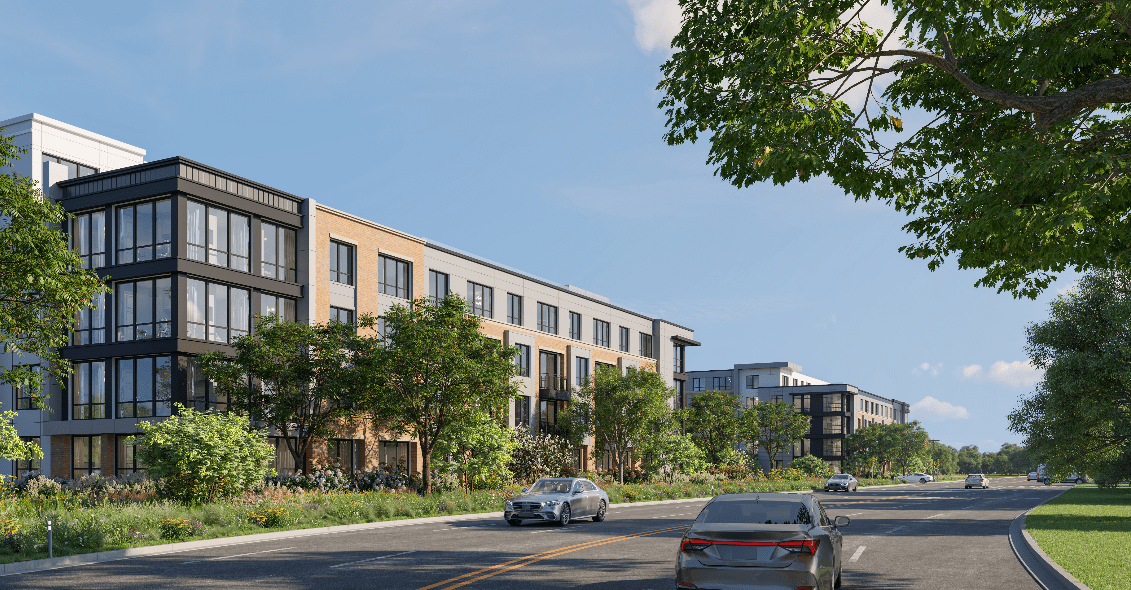
Rendering by Minno and Wasko of the Residences at Heritage Park at 1700 Asylum Avenue. Town of West Hartford website image
By a vote of 8-1, the West Hartford Town Council approved a proposed 322-unit development on what is now a parking lot on the eastern portion of the former UConn campus.
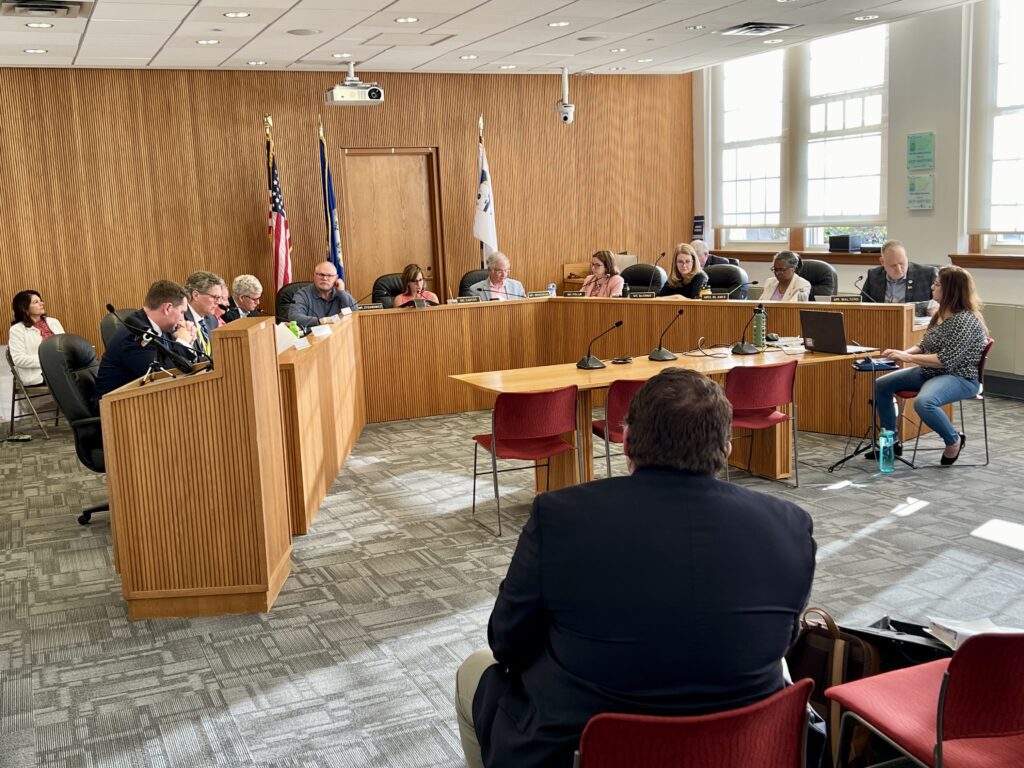
The Town Council held a 5-hour public hearing before voting to approve a 322-unit development on the 1700 Asylum portion of the former UConn campus. Photo credit: Ronni Newton
By Ronni Newton
The Residences at Heritage Park, a 322-unit multifamily development at 1700 Asylum Avenue on the 23.78-acre eastern portion of the former UConn West Hartford campus, will move forward after gaining approval from the West Hartford Town Council in an 8-1 vote late Monday night.
With the approval, the entire 1700 Asylum property will become a Special Development District, with 8.92 acres that is currently the ballfields and playground area on the southern portion of the site remaining an R-10 (single-family residential) zone, while the 14.86 acres northern portion, most of which is currently an 1,100-space parking lot, will be rezoned as RMMS (residential multifamily, multistory).
The redevelopment of the campus – which has been vacant since 2017 – has long since been on the horizon as one of the most transformative opportunities for the town and the region, and not only did extensive discussion and debate take place Monday night, with many testifying passionately against it and an attempt to force a supermajority through a protest petition, but there have also been countless hours of study and countless pages of documents that have been reviewed along the way.
Thousands of pages of of documents accompanied the application that was considered Monday night, with a parking study that alone is nearly 700 pages, and plans to transform the former campus property have actually been on the horizon since the University of Connecticut announced in 2012 that it planned to leave West Hartford and create a downtown campus.
Town staff has been actively working on various issues related to the site since 2017, when UConn moved out and the town was considering buying the property, and it has been a long journey “to bring in a development that would be in the best interest of our community,” Mayor Shari Cantor said just before the Council vote. “This is so important for us to have all the perspective … to think about globally what impact will this have on our community.”
The Residences at Heritage Park – estimated by the developer to generate at least $1.8 million in tax revenue – is an important project for the town’s financial stability, and for overall investment in the community, she said, and as a signal to investors who want to be in the community. A third of the parcel will remain recreational space open to the public, she added.
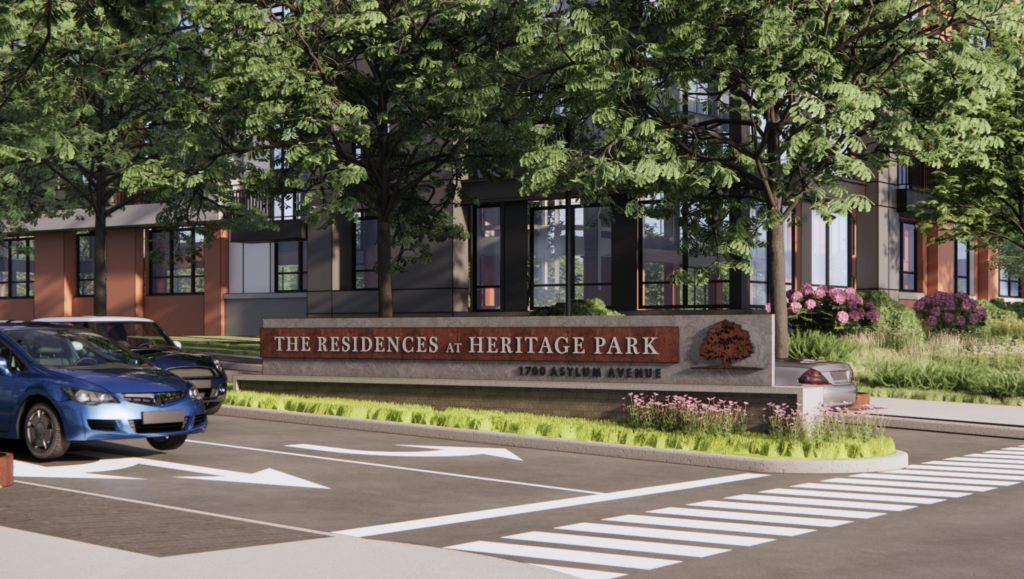
Rendering of proposed entrance to The Residences at Heritage Park – the new name of the proposed development for the former UConn campus in West Hartford. Courtesy image (we-ha.com file photo)
The securing of a wetlands permit by the developer, which was a necessary first step before any official discussion of the change in zoning required to built apartments, was the subject of roughly 15 hours of public hearing split into three meetings, and received unanimous approval from the Town Plan and Zoning Commission (TPZ) in their capacity as the town’s Inland Wetlands and Watercourses Agency (IWWA) on Jan. 17.
Cantor said the study and countless hours of analysis and discussion that preceded the wetlands approval will result in improvement to the stormwater on the site, which currently runs off the parking lot and other portions of the property directly into Trout Brook and other watershed areas without any treatment.
“This development is not happening because we want the grand list grown, but it is happening because we want homes,” Cantor said, and these will be built on what’s currently a parking lot. And while there are more than 1,000 units of multifamily housing currently in various stages of development, she noted that since the approval of Blue Back Square two decades ago, there were virtually no applications until recently.
Before the Council meeting – that ultimately didn’t begin until 10:35 p.m. – a five-hour public hearing that included a presentation from the developer as well as testimony from more than two dozen members of the community. That hearing was initially planned for March 11 but after a 45-minute delay that night was was postponed to allow the developer to respond to critical questions regarding emergency access and other issues that had been raised by town staff.
“Tonight, we presented our development plans for the Heritage Park residences on 1700 Asylum Avenue to the West Hartford Town Council, having earned a positive recommendation from the Town Plan & Zoning Commission, Inland Wetlands & Watercourses Agency and Design Review Advisory Committee,” said Dominic Carpionato, principal of West Hartford 1 LLC in a statement provided to We-Ha.com Monday night. “Each step of this rigorous public review has helped improve our designs, minimize the impacts to site wetlands and existing trees and ensure that we conform with the town Plan of Conservation and Development,” he added.
Now that the application has been approved, Garden Homes, which has been part of the West Hartford 1 LLC development team, through the entity K & K Developers Inc., plans to take over the ownership and management of the Residences at Heritage Park as noted in an Affidavit of Interest that is part of the application. Garden Homes, a New Jersey-based company established in 1954, owns more than 55,000 apartment units in nine states, including developments in Simsbury, Hamden, Manchester, and Bloomfield, with another under construction in Trumbull. Garden Homes intends to be a long-term owner, said attorney Robin Pearson of Alter Pearson LLC, who represents West Hartford 1 LLC and is part of the overall development team.
Garden Homes has “long-hoped to have an opportunity to come into West Hartford,” Pearson said. The company is owned and managed by Eli Pechthold, who was present at the hearing and meeting Monday night.
Pearson told We-Ha.com that the transfer of ownership will take place following the initial permitting process, with work planned to commence in 2024.
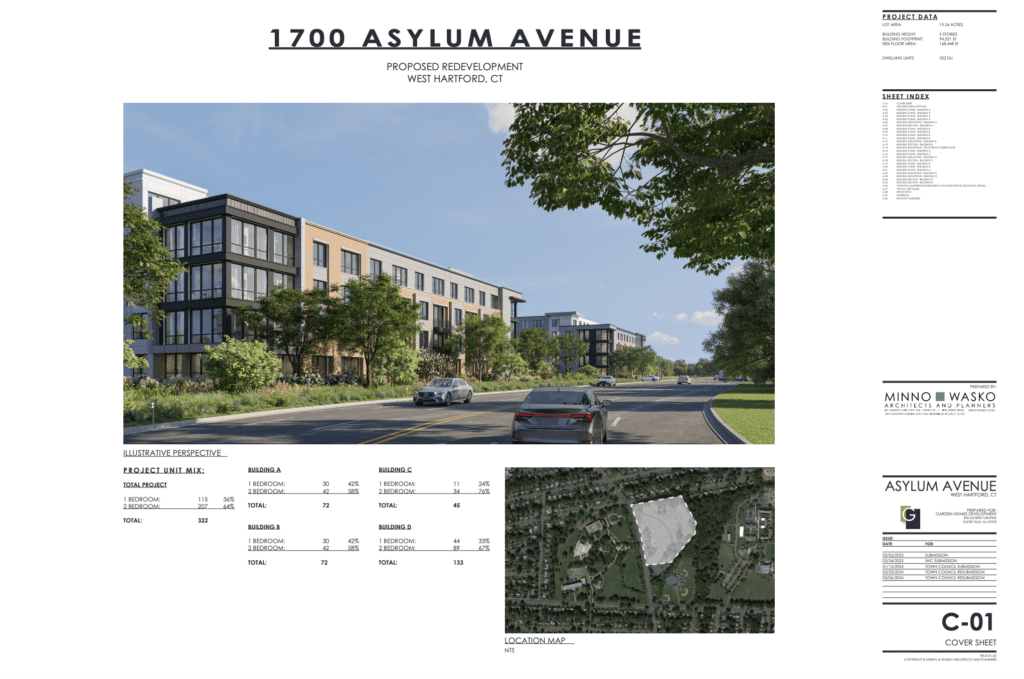
The West Hartford Town Council held a public hearing on April 15 on the application to develop 1700 Asylum Avenue into the Residences at Heritage Park. Town of West Hartford website image
Presentation by the developer and specifics of the apartments
In her presentation at the public hearing, Pearson stated that the development, while in an area that includes a robust neighborhood of single-family homes, is also bordered by “large tract institutional uses” including the University of Saint Joseph to the east and the still-vacant 1800 Asylum portion of the former UConn campus to the west. The commercial area of Bishops Corner is just to the northwest, and on the other side of USJ are the 208 multi-family residential units at 243 Steele Road.
“The use that’s being proposed … is appropriate given the context of the existing zoning of the area,” Pearson said, adding that the SDD designation will encumber the property to prevent a change in use without approval of the Town Council. Since the ballfield area will remain in an R-10 zone, there is no as-of-right ability to redevelop that for other use.
Matthew Bruton, a civil engineer with BL Companies, also part of the development team, outlined some updates to the proposal, including a dedicated entrance and 100-space parking lot for the roughly 8.9-acre ballfield section that will be constructed by the owner.
The residential development will include 322 units – 115 one-bedroom units and 207 two-bedroom units, with 558 parking spaces. The two-bedroom units will range from 1,240 to 1,340 square feet, and the one-bedroom units will be 850 to 950 square feet. Some units also have dens. Rents, according to Pechthold, will likely be similar to those at the new One Park development – around $2,000 per month for a one-bedroom and in the $3,000 to $3,500 range for a two-bedroom.
Twenty-six of the units (10 one-bedroom and 16 two-bedroom), comprising 8% of the total units, will be set aside as affordable to those who earn no more than 80% of the Area Median Income (AMI), and guaranteed for 30 years.
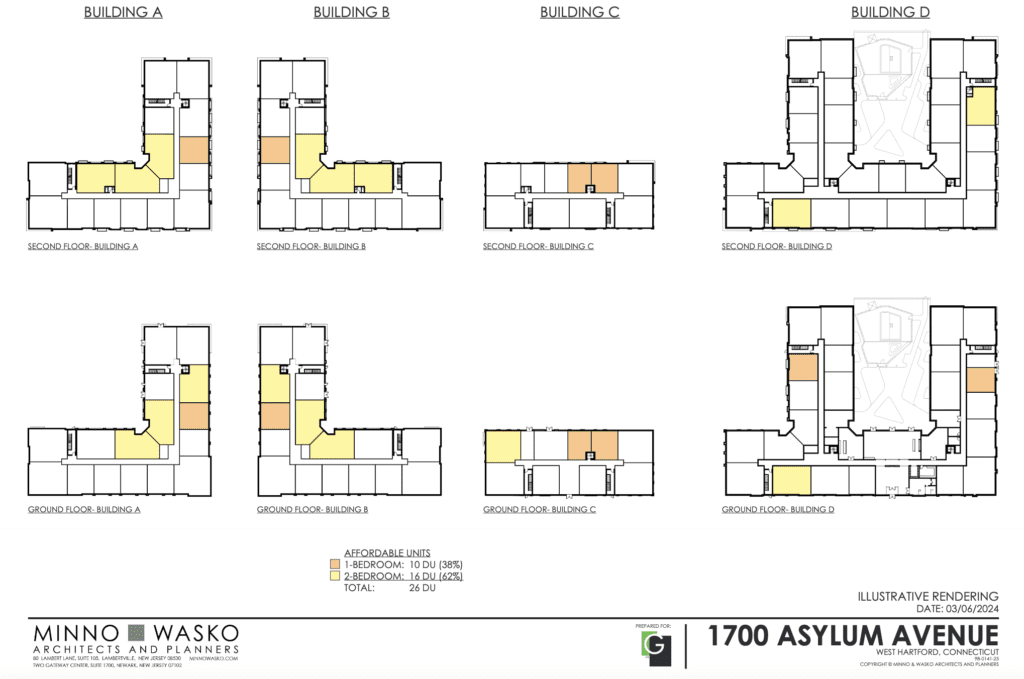
Planned location of affordable units at the Residences at Heritage Park. Town of West Hartford website document
There will be a bridge to the ballfields, extension of the sidewalk along Trout Brook Drive from Asylum to the south to Lawler Road to the north, and preservation of the Champion White Oak.
The site, which currently has 517 trees, will contain 823 when complete, Bruton said. There will be abut 116 trees demolished during the process, some of which are dead, he said. New trees will be roughly 2-4 inches in diameter.
Michael Lawson of Minno Wasko Architects & Planners, said there will be four buildings, the largest of which includes 133 units and the clubhouse. All buildings will have a fifth story, but buildings A and B, which front Trout Brook Drive, will have that fifth-story stepped back 30 feet, so the buildings will appear as four-story structures from the road – a change which was made following input from the town’s Design Review Advisory Committee (DRAC), which recommended approval of the project by a 3-1 vote in February.
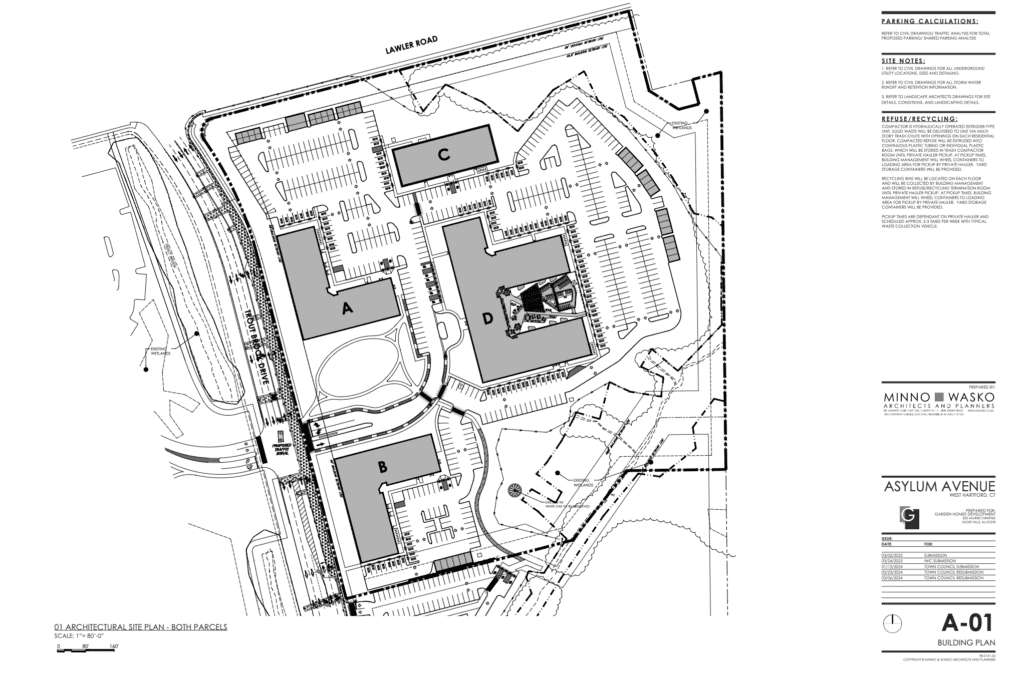
The West Hartford Town Council held a public hearing on April 15 on the application to develop 1700 Asylum Avenue into the Residences at Heritage Park. Town of West Hartford website image
“Garden Homes brings a wealth of knowledge when it comes to amenities,” Lawson said, and that will include spaces for yoga and fitness activities, co-working space, lounge areas, a pool, and barbecue grills. Buildings A, B, and D will also include rooftop terraces with shade structures, firepaces, and seating.
There will be extensive landscaping, he said, dark-sky-compliant lighting, energy-star appliances, and 10% of the parking spaces will have electric vehicle charging equipment with infrastructure in place so that another 10% of the spaces can be adapted for EV charging in the future. While there will not be solar panels on the rooftop – Lawson said in response to a question that due to the penetrations through the roof for condensers and other equipment needed for multifamily residential there’s not the large expanse of area needed to make solar feasible – the roofs will be light-colored to avoid creating a “heat island.”
There will also be a wetlands mitigation and stewardship/management plan as part of the development, along with a conservation easement that has been agreed to by the developer.
Lawson also outlined a trash management plan that involves trash and recycling chutes on each floor leading into a collection area in a room on the ground floor. That’s where trash will be compacted and then hauled away two or three times per week.
Traffic engineer Rob Baltramaitis summarized the nearly 700-page traffic impact study, and said traffic counts were done at 16 intersections in the area, and included analysis of expected future traffic impact based on the development as well as what would be expected in a “no build” situation that includes other approved town developments but not this one.
With the Residences at Heritage Park, the study indicated 122 extra trips at peak morning commute, 120 at peak afternoon commute, and 120 trips at a peak Saturday afternoon time.
While members of the public in the audience laughed when he indicated little impact of traffic, Baltramaitis said that traffic engineering is a science and uses scientific modeling.
The only intersection expected to have a negative impact is Albany Avenue, and that delay is estimated at about 4 seconds, he said, without any changes in signal timing.
The developer plans to widen a portion of Trout Brook Drive to add a dedicated southbound left-turn lane into the residential area driveway, and continue the turn lane for the entrance to the ballfields.
The addition of a traffic signal at the entrance to the Residences at Heritage Park cannot happen without the approval of the state Department of Transportation, and Baltramaitis said there would not be enough traffic generated from the development of 1700 Asylum to warrant it. If 1800 Asylum is ultimately approved there would likely be enough traffic for the addition of a signal, but the town currently does not have an active application for development of that parcel and it therefore could not be considered.
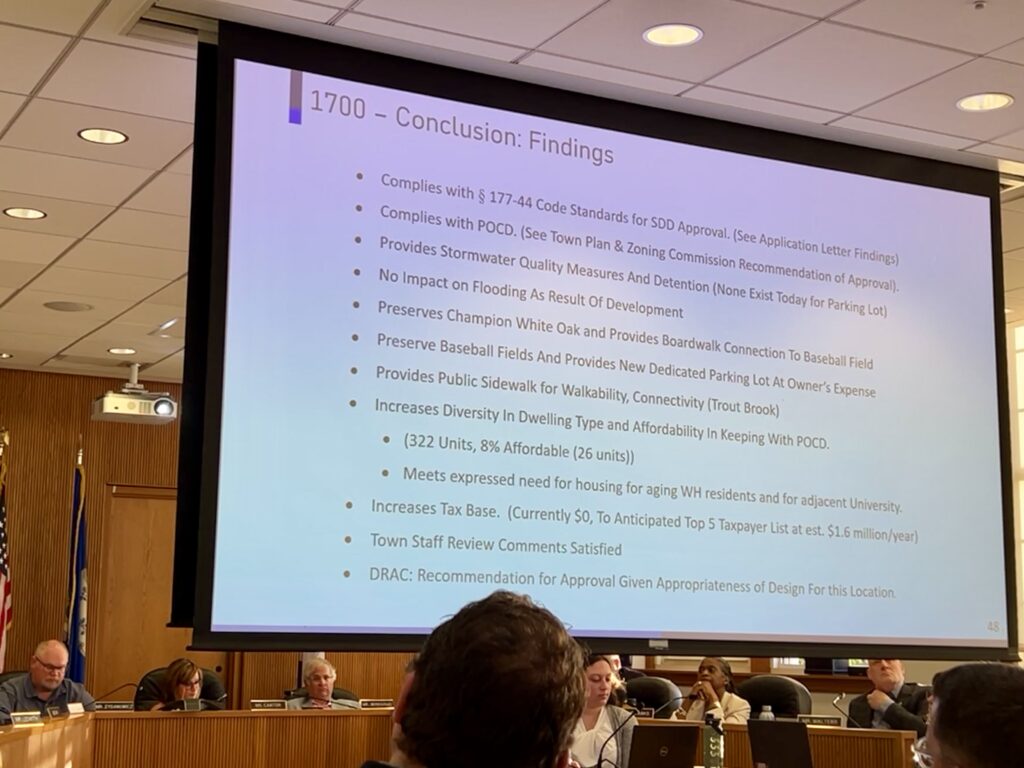
Among the statements made in conclusion, the developer states how the project complies with the West Hartford’s POCD. Photo credit: Ronni Newton
A resubmission of the wetlands application for 1800 is expected to come, and if approved a discussion about zoning will follow.
“We are grateful for the Town Council’s consideration tonight and their affirmative vote, and we look forward to continuing the permitting process for the parcel at 1800 Asylum Avenue to bring forward the small, vibrant village to the neighborhood and give West Hartford a great place to live,” Carpionato said in his statement.
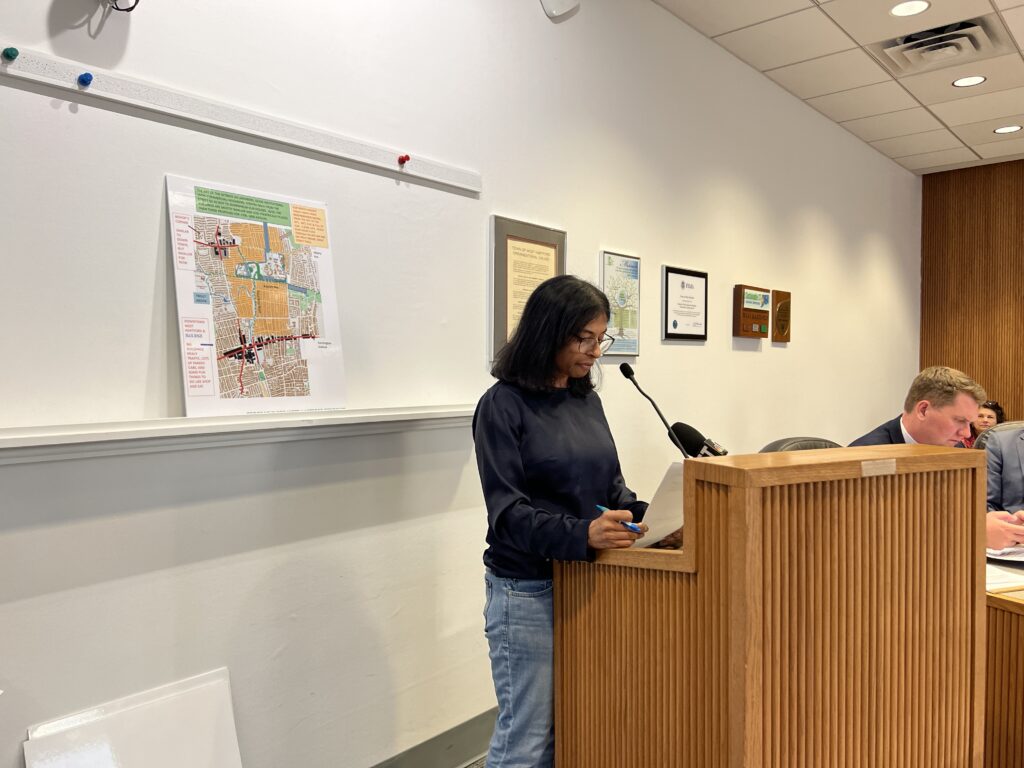
Sandra Rampertab speaks at the public hearing about 1700 Asylum on April 15,, 2024. Photo credit: Ronni Newton
Public comment
There were 27 speakers who addressed the Town Council on Monday night, and about 20 pieces of written testimony, some of which came from the same individuals.
Many of those who spoke against the project were abutters or live in the surrounding area.
“Tall towers and buildings do not belong in our neighborhood for a number of reasons,” said Sandra Rampertab. The town conducted a visioning process in 2018 which indicated overwhelming support for making the property a park, she said, and the “town failed to consider the wishes of West Hartford residents.”
Resident Ruth Miller said the standards for a Special Development District require that a project “must be in harmony with actual or permitted development of adjacent properties,” and said this proposal is such closer to the street than any other development nearby. It’s “all about proportionality between the buildings and the street,” she said, requesting a negotiation with neighborhood residents to ensure it would be in harmony.
“This project is too big for our neighborhood. We do not need these apartments,” said Lois Bures, who said fighting against it was like David and Goliath. “You, the Town Council, stand between us and the runaway freight train of this development,” she said. “When did the grand list become more important than the residents who live here?”
Charlotte Gara said, “Heritage Park is not the right fit for this site in West Hartford,” and said while canvassing the neighborhood she met with many residents, including those who live on Haynes Road, Lawler Road, and Trout Brook Drive, who told her they had spoken with real estate agents who said the construction of the development would cause the values of their homes to drop by $100,000-$150,000.
The development will ruin the integrity of the Morley neighborhood, Gara said, recommending instead no more than three-story buildings set back 150 feet.“The developer could then use the land by Trout Brook Drive for building parking spaces,” she added.
Chris Henegan presented a petition stating:”I am against zoning changes to the 1700 Asylum Avenue property in West Hartford Connecticut from one-family residential to a Special Development District. The zoning for these properties should remain as it currently is today, where only single-family residential homes can be built, Do not change zoning from R-10 to a Special Development District.” The petition had 10 pages of signatures, and Henegan was permitted to obtain additional signatures while the hearing was in session.
The Town Clerk and Corporation Counsel’s offices were involved in verifying the signatures were authentic and from the deed holders of properties within the 500-foot buffer. If the petition qualified as a protest petition and had signatures of 20% of all property owners in that abutment area, it would trigger the need for approval of the Town Council by a supermajority. It met the former, Corporation Counsel Dallas Dodge said, but only 11% of the total deed holders had signed based on a review of records.
Glenn MacIntyre said he’s a member of the fourth of fifth generations in his family to live in town, and this is ruining the reason why people come to West Hartford. “Crime will be increased because these people will be renting, not showing commitment to the town long-term,” he said “This is the Town of West Hartford, not the City of West Hartford.”
Mike Michaud, as executive director of the Miracle League of Connecticut and a past president of the West Hartford Little League, didn’t take a stance on the project itself, and while he said he appreciated the fields will be left intact he expressed major concerns about having just 100 spaces for parking. “I just don’t see how 100 spots are going to cut it,” Michaud said.
Opening day will have 600 families at the field, and there are about a dozen times a year when parking will be completely inadequate. In addition, the Miracle League players have disabilities, and can’t park far away, and previously when people have parked on nearby neighborhood streets that has created issues with those residents.
Michaud also expressed concern about the lack of a long-term lease for the property, which is important because the Miracle League field is in need of replacement and while consideration of the project has been underway the cost of that work – which will be financed with donations raised from the public – has risen dramatically.
There were others who spoke out strongly in favor of the development, including Chamber of Commerce President and CEO Chris Conway, who said the organization’s economic development committee endorsed it. “This will benefit the towny replacing surface parking with housing,” he said.
University of Saint Joseph President Rhona Free also spoke in support of the project, including the major benefit in stormwater management. She said based on her experience with the town, the developer will be held to that commitment to remedy stormwater issues.
Free also said the additional units will be welcomed as potential housing for faculty and graduate students. USJ has been trying to cut down on having people drive to campus, and while some can live at the 243 Steele Road development and bike or walk, there isn’t enough capacity to house roughly 60 new faculty hired each year as well as graduate students in pharmacy and physician assistant programs. She said she also looks forward to sharing the campus art museum and other programming with new residents.
Resident Jason Wang said he supports rezoning and redevelopment, and there’s a very strong argument to be made for infill development. “Single-family housing compared with single-use zoning is the most carbon-intense way to live,” he said, and this type of development is better for the environment and may encourage “light car” households. “A car-dependent lifestyle is not good for our health,” he said, and this will turn a decrepit parking lot into a vibrant and walkable area.
Wang said he grew up in Saint Louis and while his family was not wealthy, he had access to a good school district because there were reasonable apartments in the area. “I don’t want West Hartford to wall ourselves off,” he said, from having diversity in housing.
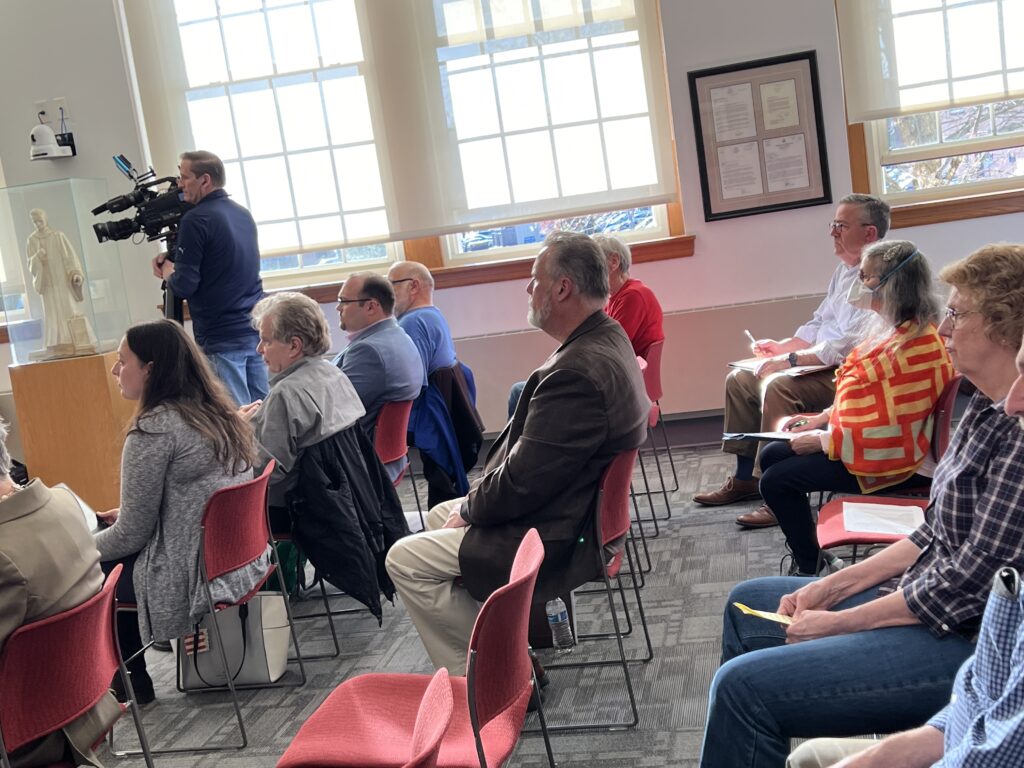
Speakers listen to the developer’s presentation while awaiting the comment portion of a public hearing on April 15, 2024. Photo credit: Ronni Newton
Town Council comments and vote
Council members had a chance to ask questions of the developer during the hearing, which adjourned at 10:35 p.m. after five hours of testimony, and also commented before voting during the special Town Council meeting that followed.
Democrat Deb Polun asked about the number of students the development will generate for the town’s schools, and Pearson said it will be minimal based on the number of additional students the Steele Road apartments have generated. Town Manager Rick Ledwith said Steele Road has added on average four students.
“I feel confident that the applicant has met the requirements” for a special development district, Polun said before she voted. “It is a dense project… but we also know that dense development is better for the environment,” and this location is really convenient for transportation, and it’s walkable. “I’m happy to gain a couple hundred new neighbors,” she added.
Republican Mary Fay – who cast the lone dissenting vote – asked if the trash management plan, with the trash compactors “would compound or alleviate the problem” with rats that residents have raised concerns about. Lawler, the architect, said more pickups and the location of the chutes inside the building would minimize issues. A pest management plan is also one of the standard conditions of approval for all Special Development Districts.
Fay also expressed concern that the project will increase costs for more teachers as well as public safety. Ledwith said the police and fire departments have reviewed the application and don’t foresee a need to add staff.
Fay said older people often want to remain homeowners, and asked why apartments and not condos, and Pearson said the rental market for multi-family housing is much stronger than single-family or the condominium market.”
Prior to voting, Fay said she knew that she would likely be the only Council member not supporting the project. “This doesn’t fit the location. It’s way too big, it’s way too dense. … It doesn’t belong there,” she said. “We need to listen to our residents who are already here.”
First it was accessory dwelling units, and now multifamily development disrupting single-family neighborhoods that were here first, Fay said, but added, “You come back with three stories, I’d probably say yes.”
“It’s been a long road,” Deputy Mayor Ben Wenograd said. “I believe that this is a very strong plan, with the benefit certainly to the town as a whole and in the end to the neighborhood as well.”
The project deserves to move forward and will be a great asset to the town, and will also provide 26 more affordable homes for people who might not otherwise afford to move to this community.
Wenograd also said the development will provide improvement to stormwater management, noted that “multifamily homes are better for the environment,” with a smaller carbon footprint per person as opposed to a single-family development on the site – which would likely be large homes that that not only would be horrible for the environment, he said, but would not add to diversity of housing.
“What we’re talking about here – we’re replacing a parking lot and building homes for people. … I can’t think of anything better than building new homes,” Wenograd said, for current and new residents.
Minority Leader Mark Zydanowitz said he’s watched the changes to the proposal, and the setback so that the fronting on Trout Brook is four stories was a great compromise. While the abutting homes are single-family, he added, multifamily isn’t far away with Bishops Place on Albany Avenue, for example, a “par 5 if you’re good.”
Zydanowicz recalled the debate on the Steele Road apartments which lasted until 2 a.m., and said at the time he would have been one of those who disagreed with the traffic study, “and I don’t think there is a resident out there who’s noticed the traffic.” He added that over the past two years, as the parking lot has been overflow parking for St. Francis Hospital employees, there have been 700 to 800 cars parked there at a time and buses every seven or eight minutes, “and maybe one complaint came into town.”
Zydanowicz said he and other Council members do listen to the neighbors, and appreciates all who came out, but they have to worry about the 64,000 residents of town. Responsible growth is essential, he said, and the town actually has 4,000 fewer residents than it had in 1970. “You need to grow, you can’t stay stagnant. Growth is not a bad thing.”
“I know that change is hard, I know that change is difficult, and I really do understand the concerns that people brought up,” said Democrat Tiffani McGinnis, who said she lives near the area and thinks this is a very good project about which she is excited.
“Renters are a part of our community. And I know I can’t speak for all of my colleagues, and just because you rent a home and don’t own a home doesn’t mean you don’t care about the community,” she added, and multifamily is better for the environment.
Burke Doar, the zoning alternate for Republican Alberto Cortes who was absent Monday night, formerly served on the Town Council and was among those who supported the 243 Steele Road development at the time.
“This is an application to amend an R-10 to an SDD,” he said, and in his estimation it does meet that criteria and is proportional to the neighborhood. Steele Road is an important comparison, he added, but a major difference is that Trout Brook Drive “is a four-lane road and it is a major artery in this town, but it is encumbered by two properties that are in distress,” which will be enhanced by this project.
We should embrace renters, Doar said, adding that he was upset by “the idea that we would somehow be critical or in any way be less welcoming to people” who rent, and that we need the elementary schools to be “robust” and full of students.
Democrat Carol Blanks said she is glad the developer hung in there through the process, and listened to the residents and made huge modifications to the original proposal. At the same time, she said she understands that they “don’t want to create a project where you are going to lose [money].”
Growing the grand list is essential to being able to provide the great services that residents want, as well as to be open and embracing to those who need different types of housing stock options. “It takes a lot of work and it takes compromise. We’re in 2024, we’re not in 1964, and it advances forward and our housing looks a little different,” she said. “How are we being inviting as a town if we say we only want single family residents?”
Like many, Blanks said she moved to West Hartford so her children could be educated here. “I think years from now we’ll look down the road and think we made the right decision.”
“We live in a place where voices can be heard, and it’s not automatic,” Democrat Barry Walters said of the approval, and if it were, this would have been a done deal years ago.
While he respects those who just don’t want this development, West Hartford is an ex-urb – in between urban and suburban – and this piece of property “is a mess.” The application isn’t for a high-rise, but rather a four- to five-story building, set back and surrounded by trees. While there won’t be solar energy, he noted that there are other elements that are positive for the environment like adding native plantings and the conservation issue.
“I think it’s going to be great asset,” Walters said.
Cantor said it’s important to put this project in perspective along with other developments around town. There is no tax abatement requested, and she said the reason there was a 10-year abatement plan approved for the One Park development was because for years there was the attempt to obtain financing, but it wouldn’t work without the historic tax credits the developer was unable to get to help keep the 100-year-old chapel.
Multiple developers have looked at the former UConn campus, and nothing has worked, and all the realtors she has talked to believe it will increase, not decrease real estate values.
“This company has a fabulous reputation,” she said of Garden Homes. ” Thank you for your investment, thank you for being here.”
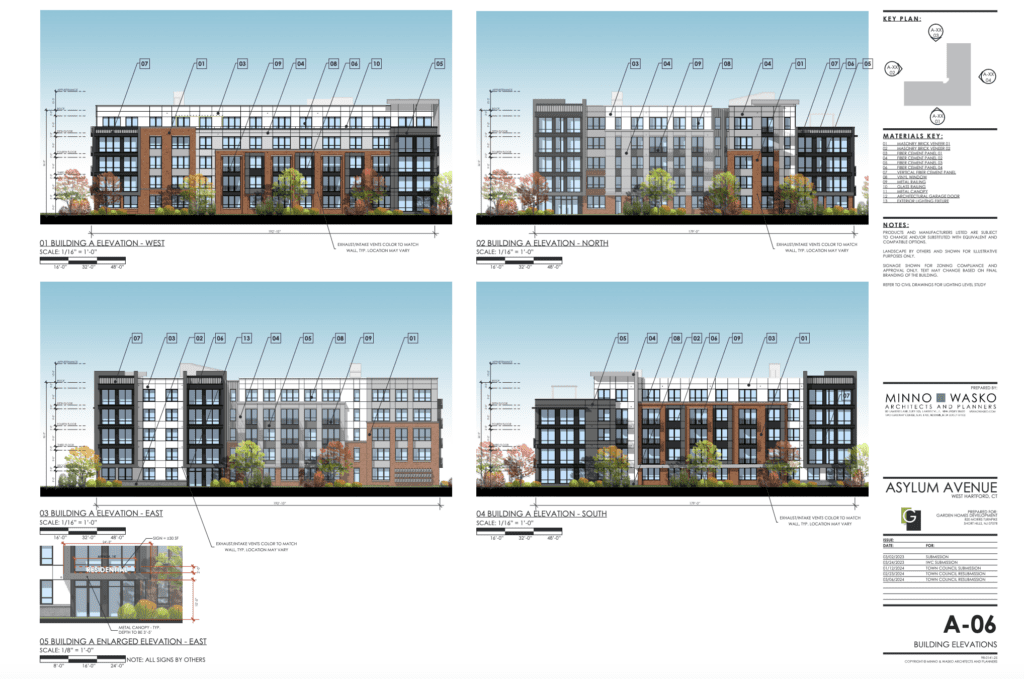
The West Hartford Town Council held a public hearing on April 15 on the application to develop 1700 Asylum Avenue into the Residences at Heritage Park. Town of West Hartford website image
History
It’s been more than two and a half years since West Hartford 1 LLC finalized the purchase of the former UConn campus property, on an “as is” basis, from then-owner Ideanomics, for $2.75 million, on Dec. 29, 2021. With the exception of the Little League and Miracle League fields and playground on the southeast corner – which the developer has committed to preserving, along with the Champion White Oak tree – and St. Francis Hospital having permission to use the roughly 1,100-space parking area for employee parking on an emergency basis because of a structural failure of their Collins Street garage – the property has been largely unoccupied since UConn relocated to its brand new campus in Hartford in August 2017.
In November 2015, UConn officially decided it would sell the property, and in 2017 opened the Hartford campus. After the town opted not to buy the property, it was purchased by Ideanomics for $5.2 million in 2018 for the purpose of creating the Fintech Village global technology center – plans for which were unveiled with great fanfare in July 2019.
While not the subject of review at this point, West Hartford 1 LLC will be paying for the cost of remediation of environmental hazards on the site – which include polychlorinated biphenyls (PCBs) and asbestos. One of the five buildings on the former campus was demolished by Ideanomics’ contractor in 2019 as part of the remediation process, and some additional clean-up has also taken place. Demolition of all of the remaining buildings is contemplated in the plan, along with any required environmental remediation before construction can begin.
[Editor’s Note: A correction has been made to the comments of Charlotte Gara, one of the residents who testified during the public hearing.]
Like what you see here? Click here to subscribe to We-Ha’s newsletter so you’ll always be in the know about what’s happening in West Hartford! Click the blue button below to become a supporter of We-Ha.com and our efforts to continue producing quality journalism.


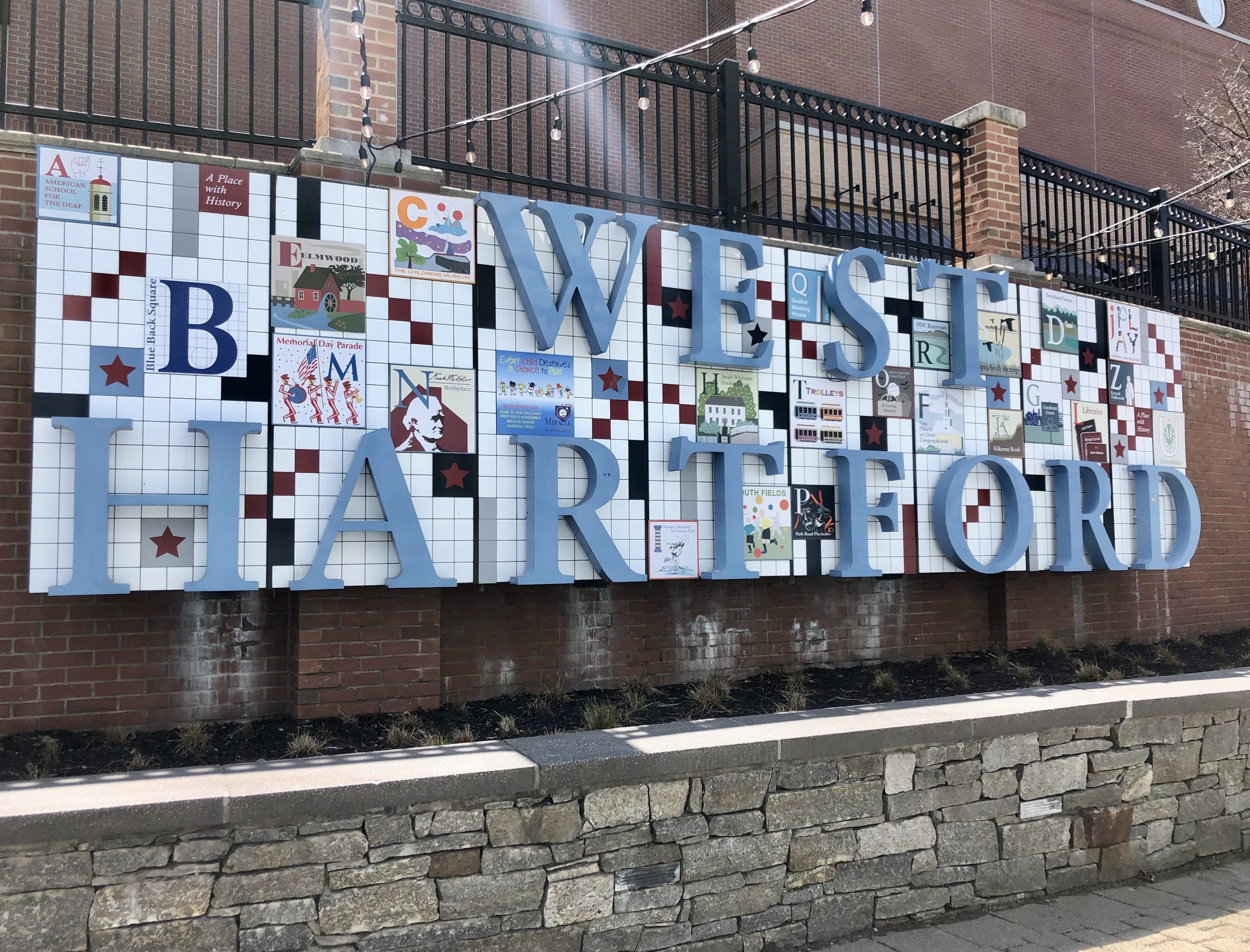

Once again the concerns of the citizens (and voters) of West Hartford have been paid lip service by a Town Council that just cannot say no to a developer. Carefully reading this article leaves me shaking my head. First of all to say “traffic study’s are scientific,” is simply not true. Having followed multiple developments throughout the region I can add some background. These studies are based on a formula that looks at “similar projects in similar cities” and says this is what to expect. Now if you take a city with no mass transit to speak of and take a city with great mass transit and say they are the same you are an idiot. That is how it is done, no one counts the cars every day to figure it out. Different places have different work schedules and traffic flow schedules.
We hear one council member say we won’t see much of an increase in the head count of students in schools… And another who says “we need robust and full schools.” Well which is it? In terms of not needing more public service personnel- fire and police- let me see. If we have 1 police officer for every 100 people and 1 fire fighter for every 100 units of housing ( hypothetical numbers) and then we decide to add “more than 1,000 units of multifamily housing currently in various stages of development” you will either have more overtime to pay or you will simply have a deterioration in the amazing coverage and response times we currently get from our exceptional fire and police.
Lastly, we are told that ” the town actually has 4,000 fewer residents than it had in 1970.” There is a reason for that. People are sick of developers ruling and taxpaying residents being ignored. Continue to destroy the beauty, history, culture, and charm for more “units” and you can watch that number drop. BTW, wasn’t Blue Back supposed to be the sure all for taxes in town? So when we Grand List all these new developments we will see falling tax bills for West Hartford as we will have all this Grand List money, and car taxes, and all the other funds from the folks moving in. (Right?)
Since it has been made clear by the 8-1 vote on this project and the rubber stamp on the others that those in office will not change their ways, there is but one solution- that is to change those making those decisions.. This from a life long Democrat
Editor’s Note: While Paul Palmer is a sports reporter with We-Ha.com, the views expressed in his comment above represent his personal opinion and do not represent We-Ha.com.
Keep voting Democrat
[…] started with the marathon hearing followed by the Town Council meeting (6 hours total) and vote on the application fo…, the eastern portion of the former UConn property. I actually started the day in North Carolina but […]